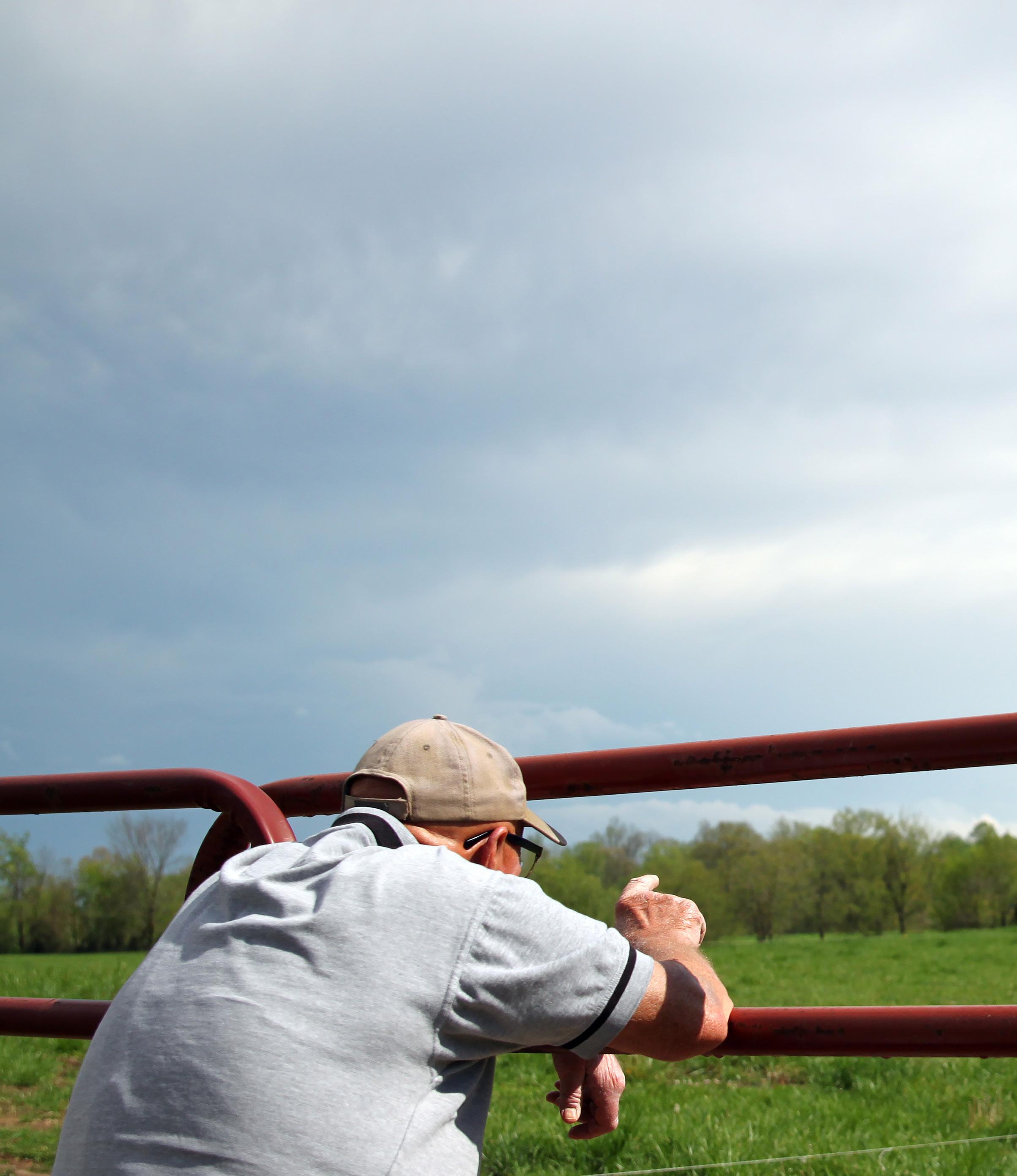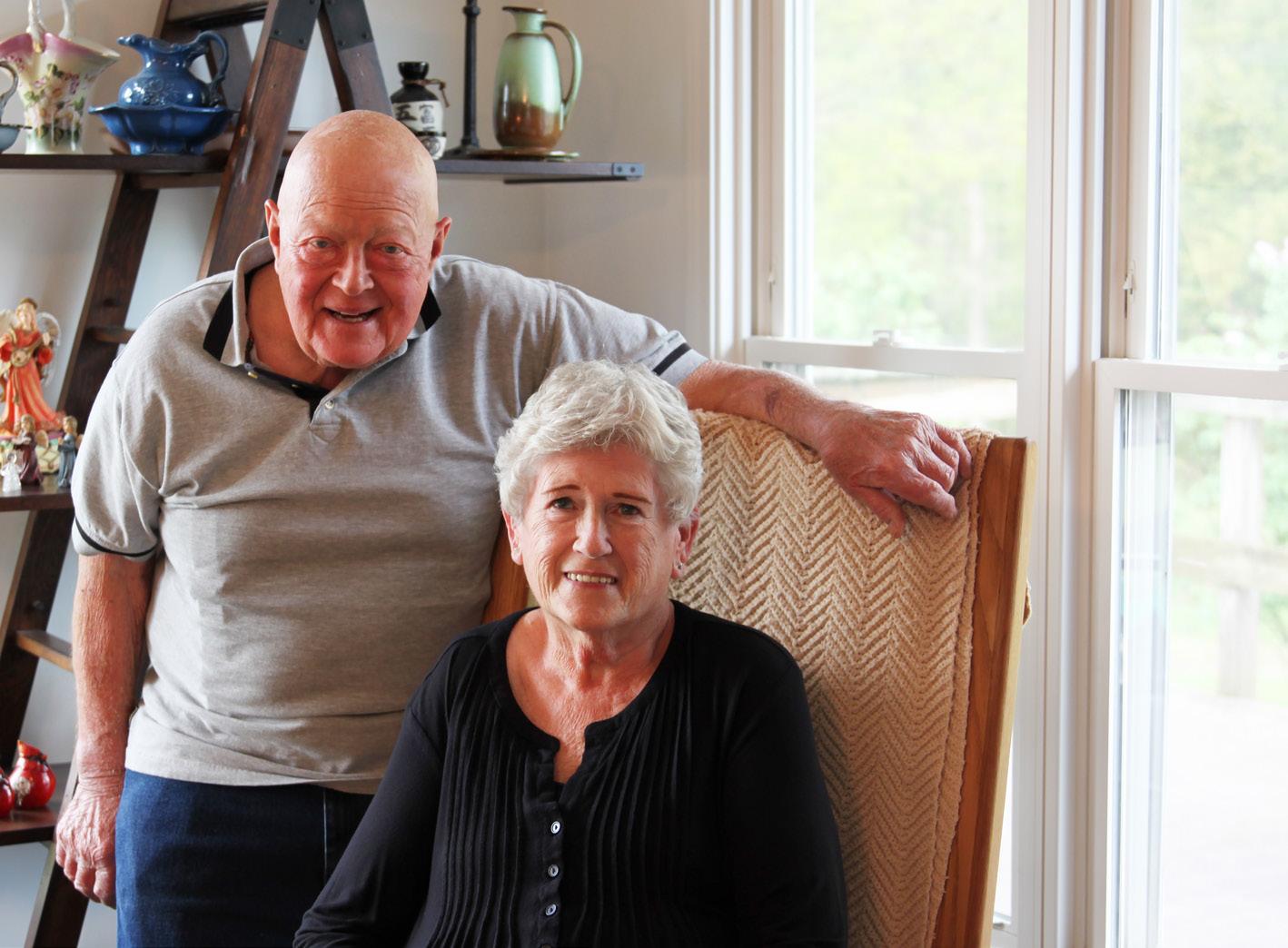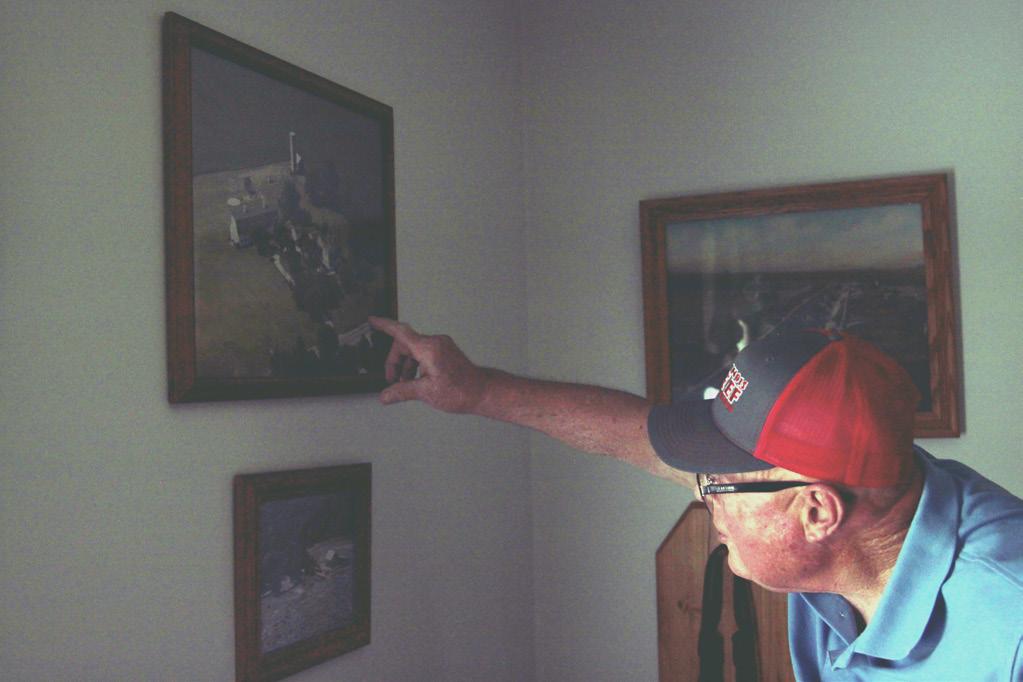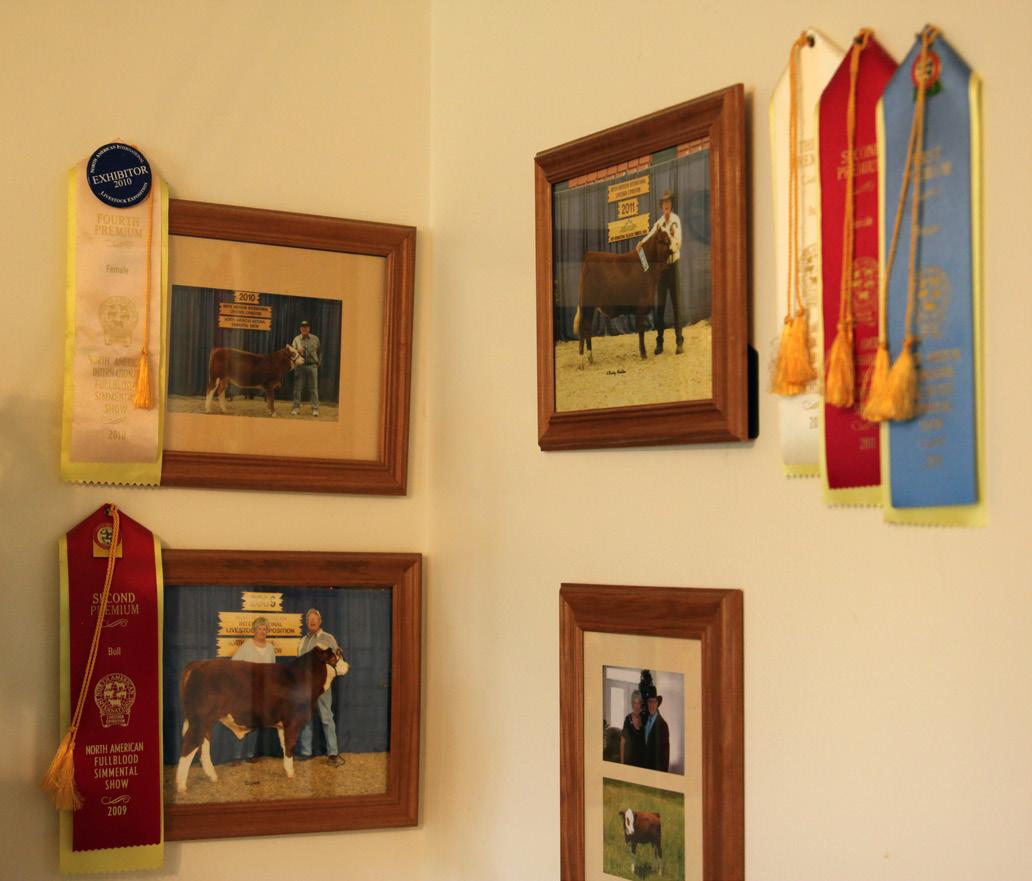
14 minute read
A Wonderful Life Indeed
The story of Chuck Weilmuenster and his journey to the cattle industry.
by Olivia Hoots
Sitting on a porch with a cup of coffee or sweet tea and listening to your grandmother tell the story of how she met your grandfather, how your grandpa used to deliver mail on horseback, or even stories from the war. What about the classic tale of how short cattle used to be in the 1950s, or how tall they were in the 70s.
Like most, Chuck Weilmuenster has his own story to tell. It is one that will make you ponder the importance of sitting down to listen to the stories of those who have lived more life than you. Chuck’s story is intriguing and his dedication to live life in a simple way, pursuing things that truly matter to him, is evident. It is a life full of meaning and deep love.
Chuck has lived through times of war, love, loss and as a cattleman. With that comes a raw and honest story, which makes him live his life today in service to his wife Jeanine, God and their family.

Chapter One: The Farm in Anna
On the outskirts of Anna, Illinois, there is a gravel drive with a painted white fence that reads CJ – Chuck and Jeanine that is – Simmentals.
Down the drive sits a clean, one-story white house with a three-car garage. Three paddocks surround the house and within them is a small pond and Fullblood Fleckvieh Simmentals.
As you walk through the door of the white house you are greeted by a large great room with windows all around and a large fireplace in the middle of the far wall. In the corner there is a handmade rocking chair where Jeanine often sits. The most frequent gathering in the space is a Bible study the couple hosts with others from their church. To the left is a kitchen filled with food to share with those who visit them. Then there’s the living room, one of the best features of the house with its large picture window looking out across the paddocks and pond.
There is much wisdom to be gained from listening to Chuck. Now in their seventies, he and Jeanine continue to live life as a journey, one that changes and grows and always loves those around them.
Chapter Two: The Beginning
Chuck’s grandfather, his mom’s father, had six farms in Jersey county near Jerseyville, Illinois. His dad was raised in East St. Louis where his mother’s father was half-owner of Robertson’s Ruralist, a farm supply store during the 1940s and 1950s.
“My dad was a city slicker,” Chuck says.
His mother’s sister owned “Cars Café,” a trolley-car themed café in East St. Louis where Chuck’s mom was a waitress. His father visited one day to eat and there met his mom. Once they were married, they moved back to one of the farms his grandfather owned near Jerseyville. Another one of the farms was a dairy herd and the couple got one of the cows to milk.
“My dad could not milk the cow, but of course my mom being a farm girl could. She would be milking the cow and squirt my dad, who would get mad at her and go in the house,” Chuck says.
It sounds as if it must have been a classic romance because in 1945 Robert “Chuck” Weilmuenster entered the world.
After some years of working various jobs, Chuck’s dad started work for McDonnell Aircraft in 1949 and worked there for 27 years.
In 1957, Chuck’s grandfather passed away. The will stated the farm was to be sold so the family moved to a Godfrey, Illinois, subdivision.
While he had been in a one room schoolhouse up until this point, Chuck now had to face the challenges a large school brought.
There was one upside Chuck eventually found in the move, however. He was now a part of agriculture classes and at that time there were only 40 kids involved, so he took the opportunity to be on every judging team. It is evident Chuck’s spirit is to be the first to volunteer and participate.
By the time he was old enough for college, he chose to follow his father’s wish to not major in agriculture. Although, he may have found a way to learn about similar things by choosing to major in biology. Southern Illinois University Edwardsville was his school of choice.
Chapter Three: Drafted
After only two years of school Chuck was drafted and while on a temporary deferment enlisted in the Air Force. He served for three years and nine months. He began as part of Strategic Air Command at the Altus Airbase in Altus, Oklahoma, and was an ejection seat specialist on Boeing B-52 Stratofortress bombers.
In the summer of 1968, the Air Force relocated the B-52s at Altus to various locations and transferred Chuck to Riverside, California, where there were 120 B-52s.
Though he had convinced himself he may not have to venture to Vietnam, by December of that year, he got orders to go. He began in Tampa, Florida, for a refresher course in McDonnell Douglas F-4 ejection seats.
Chuck arrived in Danang, Vietnam, on March 1, 1969. While there, the North Koreans shot down an American Airborne Early Warning and Control plane. Because of the incident, U.S. F-4s were diverted in route so he was then needed as a trained ejection seat person at the Kunsan Air Base in South Korea. He was there from April 1 to May 30 and was only in Vietnam for 10 months because of this temporary duty.
When in Kunsan, Chuck was called in because a Navy aircraft from the aircraft carrier Kitty Hawk had to make an emergency landing and they needed someone to safety the ejection seat. Chuck was shocked at the outward appearance of the navy plane. “It had ugly patches on the fuel tanks,” he says.
“Chuck you have got to remember, they are on a ship without parts available, unlike the Air Force,” said the sergeant. “The plane was flyable and that is all it needed to be.”
Chuck was learning not to take situations at face value. Also during his time in South Korea, Chuck was having stomach pains one day and went to the hospital on base where the doctor said it could be his appendix. They flew him up to Pusan, near Seoul.
“Son, did they really examine you?” asked the big army doctor in Pusan.
“They had a guy out of the officer club come in and punch me in the stomach several times,” Chuck responded.
“Well, he must have wanted to get back to his card game,” the doctor explained. “You just have a bad case of gas!”
Let’s just say, Chuck was a bit humbled that day. He was then set loose in Seoul to head back to his unit, but he did not have money to return so he headed down to the USO to get money for a train ticket.
As the train traveled toward Kunsan it traveled at what felt to Chuck like ten miles per hour, taking over ten hours to reach the destination. Many of the carts had entire families with all their possessions including chickens and other animals.
Once he returned to the base, he told his air force friends about what he had seen, ultimately intriguing them to want to experience the train ride too. Soon enough they were on an Air America flight back to Seoul. This time, they had their cameras to take pictures of the landscape – especially the rice paddies, unique to Chuck and his friends.
By this point in his life, Chuck was learning to appreciate the experiences he was given.
Chapter Four: I Asked Her to Dance
After Vietnam and South Korea, Chuck returned to college, this time at SIU Carbondale. While there, one of his friends invited him to go to a place called Bonaparte’s Retreat where there was a band and dancing.
“I saw a girl sitting across the way and decided to ask her to dance.” Jeanine Egan was her name, from Lombard, a subdivision near Chicago. She was there visiting a friend, Janie, who also attended SIUC.
But after that night, Chuck lost her phone number. It took over a week for him to come across Jeanine’s friend and retrieve the lost information.
“Janie, I lost Jeanine’s phone number,” Chuck said with the courage he could muster.
“She’s been waiting on a call from you,” Janie replied.
Once he was able to reach Jeanine, they began writing letters to one another. After meeting August 10, 1970, she was back down in October of that year to “visit her friend.” They then started visiting each other every two weeks.
After Chuck graduated from college on June 10, 1972, they married seven days later on June 17.
Chapter Five: Becoming a Farmer
Chuck’s first job after college was at an elevator in Dorchester, Illinois. “It was not a job for college graduates, but it paid the bills,” he says.
Not long after, a feed salesman told him about an opportunity in Carlinville where they wanted someone to start up their hog business.
They already owned some sows when Chuck arrived, a self-feeder too. The operation began with a twelve-sow feeding house made from a chicken house, but Chuck was not very pleased with the disposition of the hogs. He told his partners of his interest in getting new sows for the operation.
Their neighbor, Matt Murphey, had some crossbred sows. To resolve the issues, Chuck bought two groups of 25 sows from the Murphey’s and 25 more from a confinement at Palmyra.
“The first batch farrowed well, the second batch suffered some congenital tremors, the next batch suffered badly, and the next batch were affected so badly I barely had a five-pig average,” Chuck says. He knew he had to figure out the problem. The veterinarian told him to wait for the next farrowing and surely enough they were fine after that. Chuck continued to grow the sow herd from there.
As the farm continued to grow and profits increased, by 1975 Chuck and his business partner, Zane, were building a 50-sow farrowing house. “They did not listen to my advice and so it was built with a big pit under it,” Chuck says. “It should have been a flush gutter.” It was built with oak slats, making it difficult to clean so they had to be innovative in how they cleaned the building to ensure healthy farrowing.
In 1978, Chuck and Jeanine decided it was time to start their own operation.
“We bought a small farm in Kampsville, Illinois. It was 100 acres to raise hogs on,” Chuck says. They also had a sheep herd of 50 ewes and 15 crossbred cows with a part Simmental bull.
“We had been there about six months when the hog business took a tremendous dive,” he says.
Financial difficulties led Chuck to make a career change. In December 1985 he went to work for the Farmer’s Home Administration – now called Rural Development.
They gave Chuck the option to be in one of their 15 offices where they were hiring. All he told them was he preferred a more southern location, though he had been hoping for Anna all along.
“Will you go work in Anna?” they asked. Chuck would say this proves God works in mysterious ways.
And so, in December of 1985, Chuck and Jeanine, and their three girls Becky, Melanie and Valerie, moved to Anna, where the couple still resides today.
“We could not buy a house right away and we did not have much money,” Chuck says. “We had an old Ford truck [Jeanine] learned to drive stick shift on.”
“She had to learn a lot, she was a city slicker from Chicago,” Jeanine remarks about herself. “Chuck said he wanted to farm and all I could think of was white picket fences and I thought that sounded nice. I did not know I would end up on a hog farm and then we would have cows, but I love the cows.”
After their long journey of triumphs and valleys, the Weilmuensters were beginning to figure out what would really make them happy – beef cattle.
Chapter Six: Fullblood Fleckvieh Simmentals
Anna is where they started their Fullblood Fleckvieh Simmental operation. Chuck also went to artificial insemination school so he could AI himself.
“I went to Mississippi to the Magnolia Classic sale in the early 2000s and bought a Fullblood Simmental Heifer,” Chuck says. “That started the Fullblood herd, and I have gradually sold off the purebred Simmentals so all of the cows are Fleckvieh today.”
According to the Fullblood Simmental Fleckvieh Federation, this breed dates back to 1830 when the original Simmentaler cattle were imported from Europe where they are traditionally a dual-purpose breed. There are five different strains of Simmentals in Europe, with Fleckvieh being the German strain that is more muscular.
Chuck favors the breed for their mothering ability and gentle dispositions, as well as their strong milk production because of their history as a dual-purpose breed. This gives them the ability to have fast-growing calves.
Jeanine says the breed has proven extremely valuable for crossbreeding because of these factors. The Weilmuensters have crossbred for these reasons when developing heifers and steers.
After Chuck started building his herd, he learned some breeders were endeavoring to begin a show in Louisville at the North American Livestock Exposition because there needed to be 50 animals minimum for a Fullblood show, then they would no longer have to show against the purebred Simmentals. Chuck was enthusiastic about making this happen and entered some of his animals. He took them to Louisville three times and has the ribbons hanging in their kitchen still today.
“That got me in with some of the other breeders and they invited me to bring some of my animals down to the Magnolia Classic,” Chuck says. He has now been selling cattle there every year for almost ten years. The show is significant for U.S. Fullblood Simmental breeders. Jeanine enjoys seeing the same people every year at the show.
Their Fleckvieh operation has bled into their community, supplying animals to others in their area and work for Chucks partners who help him out day to day. Those in his circle look up to Chuck and appreciate the work he has done in creating quality cows and bulls.
Along with their influence on the cattle industry in Anna, Chuck and Jeanine have also given much of their time to Union County Cattlemen’s Association. He is currently the Secretary/Treasurer for the association, and Jeanine helps too, both influencing younger generations to be more involved in their communities. Meetings are well attended and usually include a meal and a speaker. They are also proud members of Union County Farm Bureau because of their belief in advocating for their way of life.
Chapter Seven: An Ending We All Hope For
Chuck’s gratefulness for the life he has is evident when he opens his binder. It is filled with prints of his best animals, highest sellers, grades of market animals, emails from people who have bought his bulls, pictures of his family and more.


One picture is of a young man who showed one of his Fleckviehs at the fair a few years ago. Another is titled “THE BEST COW IN MY HERD C515.” Chuck takes great pride in the success of his animals.
There is something about raising cattle that makes men never want to retire. That is what it's like for Chuck. "It's what he loves," Jeanine says.
The Weilmuenster’s story is like one of those old movies about love and loss and picking yourself up again. At the core they are two people who seek to serve the Illinois cattle industry and the people in their community. Chuck gets up every day with an attitude of self-service and living a life of which he can be proud.

